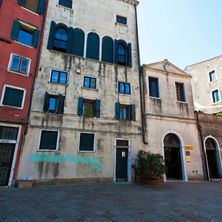

The Campo del Ghetto Novo was the territory that was allotted to the Jewish community of Venice in 1516, becoming the first Jewish Ghetto in the world. In fact, the word "ghetto" is of Venetian origin. It derives from the word "gettare," meaning to found metal and "gheto", which means slag. Back in the 14th century a foundry was located on the current square.
For centuries until the official establishment of the Ghetto, Jews coming to Venice were not treated equally. Those coming from the northern countries were allowed to stay in the Fondego dei Tedeschi, those from the East were permitted to move freely within the city, but Italian Jews, whom the Venetians used only as moneylenders, could only stay on the mainland in Mestre. It was only after the scarcity of resources due to the war with Genoa in 1382, that the Venetian Republic permitted all Jews to settle in the city. In the 15th century they were again expelled from the city and could only return in the beginning of the 16th. It was then that the Venetian authorities finally decided to give the Jews a neighborhood of their own, thus maximizing their safety and controllability.
The Campo Ghetto Novo is not only a separate square, it happens to be an island, which is connected to other parts of the city by only three bridges. When the ghetto was created three iron gates were put on these bridges and the Jews could not leave the guarded island after sunset, unless with special permission. Since they were not allowed to settle outside their neighborhood, to accommodate their expanding numbers, the Jews could only construct vertically. This is why today, besides the big noble palaces, the residential buildings in the ghetto are the highest in the city. Yet, not only did they add more floors, the Jews would also divide the floors they had, which meant that they would have walked around the house bending over. That is why today several buildings on the square have rows of windows cramped one on top of another.
Towards the end of the 16th century the Jewish population had grown so rapidly that they were given another square just over the eastern bridge called the Ghetto Vecchio. The names should not be confused however. Ghetto Vecchio does not refer to an older ghetto, but to an older foundry. In 1633 the Venetian authorities allotted yet another square for the richest Jews in the community, the Ghetto Nuovissimo, which had the most sumptuous palaces and the least restrictive regulations.
It is a fact that, due to the Venetian Republic always having been the most tolerant nation in Europe, the Jews did not have as hard a life in Venice as they did in other parts of the continent such as Spain, Portugal, Rome, Germany and other Catholic lands. Yet, the Venetian authorities did subject them to excessive taxation and they often had to pay for lavish feasts organized in honor of special guests coming to the lagoon. There were also discriminatory customs such as "the Jewish race," in which half-naked Jewish males were made to run around the streets during the carnival with Christians throwing fruit, and occasionally even stones at them. These acts were not, according to the authorities, part of official national policy, and therefore, perpetrators were usually punished.
Yet, never in Venice was the Jewish community denied its religious freedom. Nowhere in Europe did Jews feel as spiritually secure as they did in the Venetian lagoon. They had five synagogues, all representing their various places of origin: Germany, Eastern Europe, the Levant, Spain and Italy. They were allowed to publish books; their music and dance schools were always attended by Christians; their doctors were the best in Italy; their scholars helped Venetian scholars compile historical texts; certain Jews were even some of the most affluent citizens in the nation. In the 18th century they were already an integral part of the Republic.
But towards the end of the Republic the wealthy Jews had already emigrated and settled elsewhere. By the time Napoleon conquered Venice, the ghetto had become desolately dilapidated. Though with the fall of the Republic the Jews finally acquired equal social status, the ghetto would never again regain its vibrancy. Nevertheless, many Jews became fervent Venetian patriots under the Austrian occupation. The preeminent political leader and President of the one-year-long Republic of San Marco, Daniele Manin, was of Jewish origin.
During World War 2nd, when the Nazi's occupied northern Italy, about two hundred Venetian Jews were deported to the concentration camps and the pre-war Jewish population of 2000 was reduced to about 1,500 after the war.
Today about 500 Jews, orthodox and liberal, live in the Venetian ghetto. There is a synagogue, a community center, a fish shop, a bakery and a couple of popular restaurants that serve kosher dishes. The ghetto remains an important chapter in the history of the Venetian Republic and an indispensable stop on the tourist's itinerary.